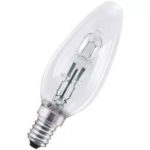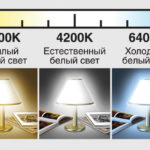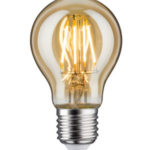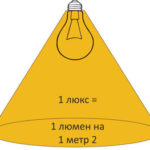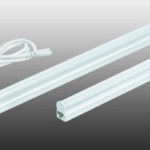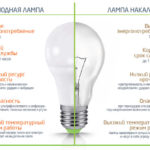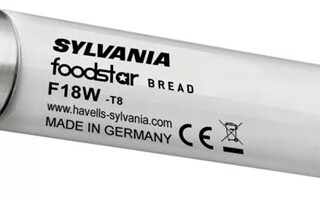Fluorescent lamps are electric gas-discharge type lamps that have a long service life. Products provide artificial lighting in residential complexes, office and shopping centers, industrial facilities. Variants of devices with different shades of radiation, type of base, tube shape, functionality, etc. have been developed.
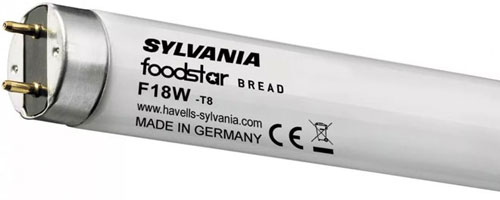
Content
The device and principle of operation of lamps
According to the history of the fluorescent lamp, the first gas-discharge type lighting device was designed in 1856 by G. Geisler. The instrument design has been improved. Fluorescent lamps entered mass commercial use at the end of the 30s of the 20th century.
The design refers to gas-discharge lighting sources, designed using a glass tube, which is sealed on both sides. From the inside, a layer of a special substance (phosphor) is applied on the surface of the lamp.The device emits diffuse light when connected to a power source. The inside of the flask is filled with argon.
The luminescent device includes:
- cathodes protected by an emitter layer;
- output pins;
- end panel;
- tubes for removal of inert gas;
- mercury;
- stamped glass leg, supplemented with electrical inputs, etc.
The principle of operation is based on the occurrence of an electric discharge between the electrodes after connecting to the mains. After the interaction of the discharge with inert gases and mercury vapor, ultraviolet radiation occurs, which acts on the phosphor, which converts energy into light radiation. To correct the shades of mercury-containing devices, phosphors with different chemical components are used.
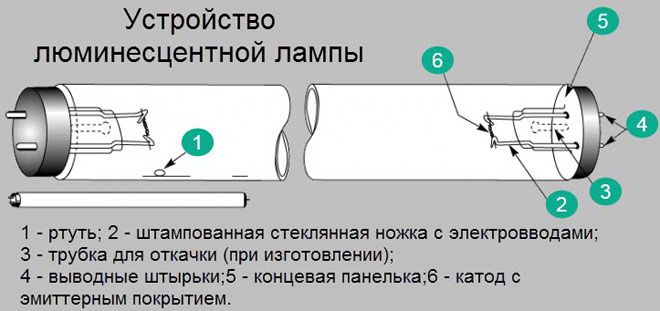
The arc discharge in the flask is created by an oxide self-heating cathode, which is affected by electricity. To turn on the DRL and LD lamps, the cathodes are heated by passing a current discharge. Cold cathode devices are triggered by ion action in a high voltage glow discharge.
For the functioning of luminescent devices, an additional unit (ballast) is required, which provides operation with a choke and a starter. The ballast regulates the strength of the discharge and is available in 2 types (electromagnetic and electronic).
The electromagnetic ballast is mechanical. The device belongs to the budget options, the device may make noise during operation.
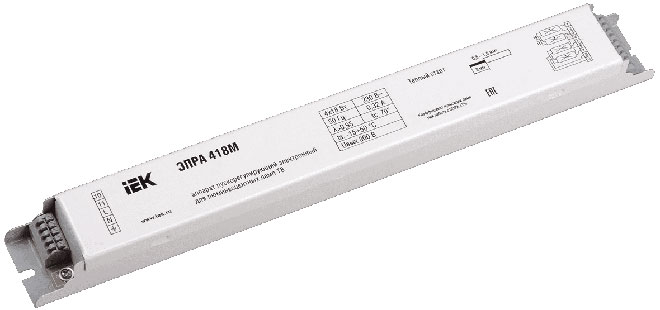
Electronic components are more expensive in cost, operate silently, quickly turn on the system, and are compact.
Classification of fluorescent lamps
In terms of spectral radiation, luminescent type devices are divided into 3 categories:
- standard;
- with improved color reproduction;
- with special functionalities.
Standard devices are supplied with single-layer phosphors, which allow emitting different tones of white. Devices are optimal for lighting residential premises, administrative and industrial blocks.
Fluorescent lamps with improved light transmission are equipped with a phosphor with 3-5 layers. The structure allows you to qualitatively reflect shades due to increased light output (12% more than typical lamps). The models are suitable for shop windows, showrooms, etc.
Specialty fluorescent lamps are upgraded with different tube formulations to maintain a given spectrum frequency. Devices are used in hospitals, concert halls, etc.
Instruments are divided into models of high and low pressure.
High pressure designs are optimal for installation in street lamps and appliances with high power.
Low pressure lamps are used in apartments, administrative complexes, industrial premises.
In appearance, LLs are presented in linear and compact versions.
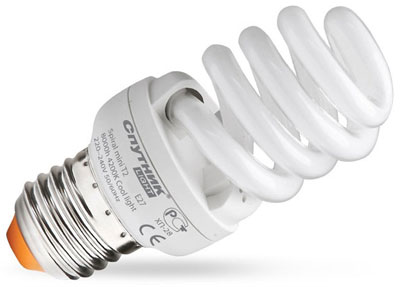
The linear design of the flask is elongated, it is used for industrial premises, shopping centers, offices, medical institutions, sports organizations, factory floors, etc. The line model is available in a variety of tube diameters and base configurations. Devices are identified by codes. A device with a diameter of 1.59 cm is marked on the package with the sign T5, with a size of 2.54 cm - T8, etc.
Compact fluorescent lamps (CFLs) are a spiral glass tube and are designed for installation in apartments, offices, etc.CFLs are divided into 2 types, the main difference is the types of socles (standard and with a pin-shaped base).
The traditional threaded plinth is marked with an "E" and a code with the diameter size.
The pin type of the base is marked with the symbol "G"; numeric data indicates the distance between the pins. This lamp pitchfork is optimal for installation in table lamps, pendant sconces in small spaces.
Fluorescent lamps differ in power (weak and strong). The power of a fluorescent lamp in W can exceed 80 units. Devices with low power are represented by products up to 15 watts.
In terms of light distribution, devices can be directional (reflex, slot type) or non-directional.
According to the type of discharge, devices are divided into arc, glow or glow discharge devices.
The scope of lighting devices differs (external, internal, explosion-proof, console).
Outdoor devices are suitable for building exterior decoration, arbor lighting, courtyard decoration, etc. When choosing, it is necessary to take into account the temperature regimes of the region.
Internal are suitable for office and residential buildings. The devices are protected from moisture and dust. The parts of the case are connected in a sealed way. The design of the lamps can be straight, suspended, designed to be attached to the ceiling surface.
Explosion-proof devices are designed for areas with a risk of explosions (warehouses, workshops for the production of dyes, etc.).
Console-type devices are mounted using special fasteners and have an individual case.
Marking
The marking of fluorescent lamps is indicated on the box and contains data on the company, power, base design, operating period, glow shade, etc.
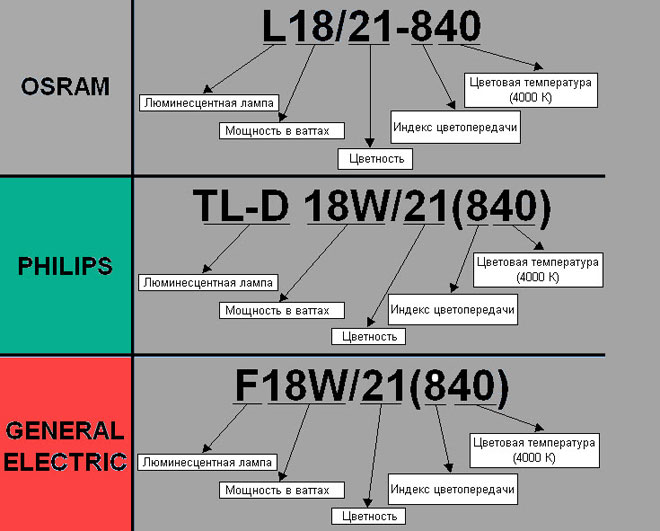
According to the decoding of the index, the first letter of the marking of luminescent type devices is L. Subsequent letters indicate the color of the device's radiation shade (daylight, white, cold white tone, ultraviolet radiation, etc.). The code value will include the characters D, B, UV, etc.
Design features on the markings are indicated by the corresponding letters:
- u-shaped fluorescent lamps (U);
- ring-shaped products (K);
- reflex type devices (P);
- quick start lamps (B).
In devices of a luminescent type, luminescence indicators are also displayed on the marking, the unit of measurement is Kelvin (K). The temperature indicator of 2700 K corresponds in hue to the radiation of an incandescent lamp. marking 6500 K denotes a cold snow-white tone.
The power of the devices is marked with a number and a unit of measurement - W. Standard indicators are represented by devices from 18 to 80 watts.
The label also presents the designation of the lamps in accordance with such characteristics as length, diameter and shape of the bulb.
The diameter of the bulb on the lamp is fixed by the letter "T" with a code designation. The device marked with the code T8 has a diameter of 26 mm, T12 - 38 mm, etc.
Markings of devices according to the type of base contain the letters E, G and a digital code. The designation for the miniature form of the threaded base is E14. The middle screw base has the code E27. The plug-in base for decorative structures and chandeliers is marked with the symbol G9.U-shaped appliances are denoted by G23, double u-shaped appliances by G24, etc.
Specifications
Technical information on fluorescent fixtures includes data on power output, base type, service life, etc.
The expiration dates of luminescent devices vary from 8 to 12 thousand hours. Characteristics depend on the type of lamp. T8 and T12 devices work 9-13 thousand hours, T5 lamps - 20 thousand hours.
The luminous efficiency of the devices is 80 Lm/W. The release of heat during combustion is low, the wind resistance is medium, the combustion position is horizontal. The parameters of the permissible ambient temperature for lamps are +5 ... + 55 ° С. Optimum operating characteristics - +5 ... + 25 ° С. Amalgam-coated devices are used at +60°C.
The color temperature indicators of devices vary depending on the model, ranging from 2000 to 6500 K. The efficiency of the lamp is 45-75%.
Color and composition of lamp radiation
The color rendering characteristics indicate the quality of the display compared to natural lighting. High color fidelity is present in halogen devices and is indicated by code 100.
There are different shades of light radiation from devices that change the color characteristics of objects.
According to the GOST 6825-91 standards, luminescent devices have the following types of emission shades:
- daytime (D);
- snow-white (B);
- natural shade of white (E);
- white with warm tone (TB);
- white with a cold tone (HB);
- ultraviolet (UV);
- cold natural glow (LHE), etc.
The addition of the C sign in the indication of color indicates the use of a phosphor composition with improved color reproduction.
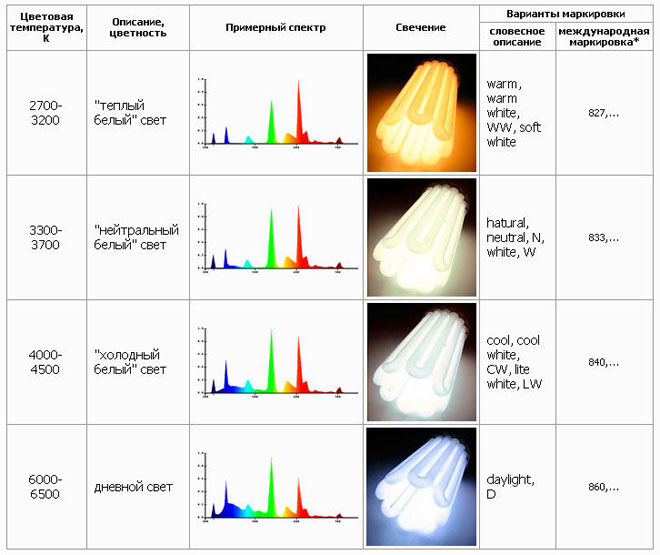
Separately, colors are indicated in lighting devices with a special purpose. Lamps with ultraviolet radiation are fixed by the code LUV, reflector devices for blue light - LSR, etc.
Advantages and disadvantages
Luminescent devices have advantages, advantages and disadvantages. Lamps have a high luminous efficiency. Fluorescent devices of 20 W provide lighting in the room, which have incandescent devices and illuminating lamps of 100 W.
The products are highly efficient. Energy-saving lamps are used for up to 20 thousand hours while meeting the requirements of operation.
The light of luminescent structures is not directed, but diffused. In the northern regions, the use of fluorescent fluorescent lamps in residential and public buildings is recommended.
The advantage of luminescent devices is in the variety of design solutions. Different shapes, color shades of devices allow implementing original design solutions in the architecture of public and residential complexes.
The disadvantages of fluorescent devices include the content of mercury in the design, depending on the size of the lamp, the volume of the substance varies from 2.3 mg to 1 g. However, manufacturers are developing designs that are not dangerous in use.
It is necessary to take into account the complexity in the installation of switching circuits and the limited power per unit (150 W). The operation of the devices depends on the climatic conditions, as when the temperature drops, the devices go out or do not light up. The luminous flux in the lamps decreases towards the end of the operation of the device.
How to choose a lamp
When choosing a lamp, the temperature regime of using the device, the indicator of electrical voltage in the network, the size of the lamps, the strength of the luminous flux, and the shade of radiation are important. The parameters of the socles of fluorescent lamps must correspond to the types of lamps, floor lamps, etc.
The selection of lamps differs according to the type of room (hallways, living rooms, bedrooms, bathrooms, etc.). For living spaces, models with a screw base and electronic ballast are suitable, because. do not have a sharp flicker and are silent.
Hallways require powerful fixtures with intense, while diffused lighting. For wall sconces, compact type fixtures with a warm tone (930) and high quality color reproduction are suitable. Above the eaves under the ceiling it is possible to mount strip lights with cold shade lamps (860) and a tubular design.
In the living room, fluorescent devices are used for sconces that are mounted to illuminate areas or decorative elements. The color is selected white, high quality (940). Installation of lighting devices around the perimeter of the ceiling is possible.
In the bedroom, it is recommended to choose standard fluorescent fixtures with an indicator of 930-933 or compact devices with similar qualities.
Lighting in the kitchen area should be multi-level (general and local). Compact devices with a power of at least 20 W are recommended as ceiling ones, the shade of light should be warm, with an indicator of at least 840. Linear fluorescent lamps that do not create glare on surfaces are optimal for arranging the working area in the kitchen.
Similar articles:
